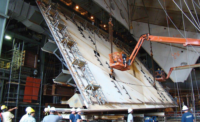

A safety manager at Gilbane Federal, the defense-contracting arm of the Rhode Island-based commercial builder, this year wrapped up a two-year rigging audit in Japan and found that local workers were securing wire-rope terminations in a manner that could cause crane loads to drop suddenly.
The safety manager, T.J. Lyons, surveyed about 90 cranes in Japan and found that workers secured wedge sockets—a compression fitting used to terminate wire rope—by clipping the live end, which carries the load, to the dead end, which hangs loose. Routine inspections did not catch the practice, which is prohibited in many parts of the world.
Experts attribute the error to tradition. "I think it's just something that has taken root in Asia, not just in Japan," Lyons says. "It is intuitive to tie the end of the cable to something else because we do it in every other cable application." The error is less common in the U.S. but still shows up as much as 20% of the time, Lyons notes. He and others recommend securing the dead end by clipping it to a piece of scrap rope; clipping it back onto itself; or clipping it to a special eyed wedge. The end should also be "dressed" with wire—never welded—to prevent unraveling (see photo, above left).
Although rigging experts say that no international standard exists, many national standards, regulations, books and other sources say the dead end should not be attached to the live end. Doing so disrupts the load path, potentially causing the rope to slip inside the wedge and wear prematurely or shear off completely.
"You should never clip the live end of a rope, no matter where in the world you are," says Marco J. van Daal, owner of Aruba-based consultant The Works International and author of the book "The Art of Heavy Transport." Bechtel's chief rigging engineer, J. Keith Anderson, who wrote the book "Rigging Engineering Basics," adds that the error in Asia appears to be "more of a common practice they don't prohibit, rather than something that is required or encouraged."
Trade journal Cranes Today, in a 2007 article on wedges, quoted an expert in Japan defending the practice as others argued against it. ENR spoke with an expert with one global crane manufacturer who confirmed the problem was common in Asia but did not say why.
Hardware makers that sell globally ask that users leave the live end alone. "You don't want to do anything that's going to jeopardize your main support," says Carl Mayer, an engineer at Tulsa, Okla.-based Crosby Group. He says wedges are designed to preserve a minimum of 80% of the wire rope's strength—any clamping or rubbing can compromise the cable.
Rigging consultant Industrial Training International, Woodland, Wash., provided ENR an illustrated memo discussing its recommendations. Download it here.



Post a comment to this article
Report Abusive Comment